Lab Final: Labs 36 – 41, 47 – 49
1/70
There's no tags or description
Looks like no tags are added yet.
Name | Mastery | Learn | Test | Matching | Spaced |
|---|
No study sessions yet.
71 Terms
What occurs if the incurrent siphon of a clam becomes blocked?
A. the clam is unable to digest nutrients
B. the clam is unable to feed
C. the clam is unable to release gametes
D. the clam is unable to eliminate waste
B. the clam is unable to feed
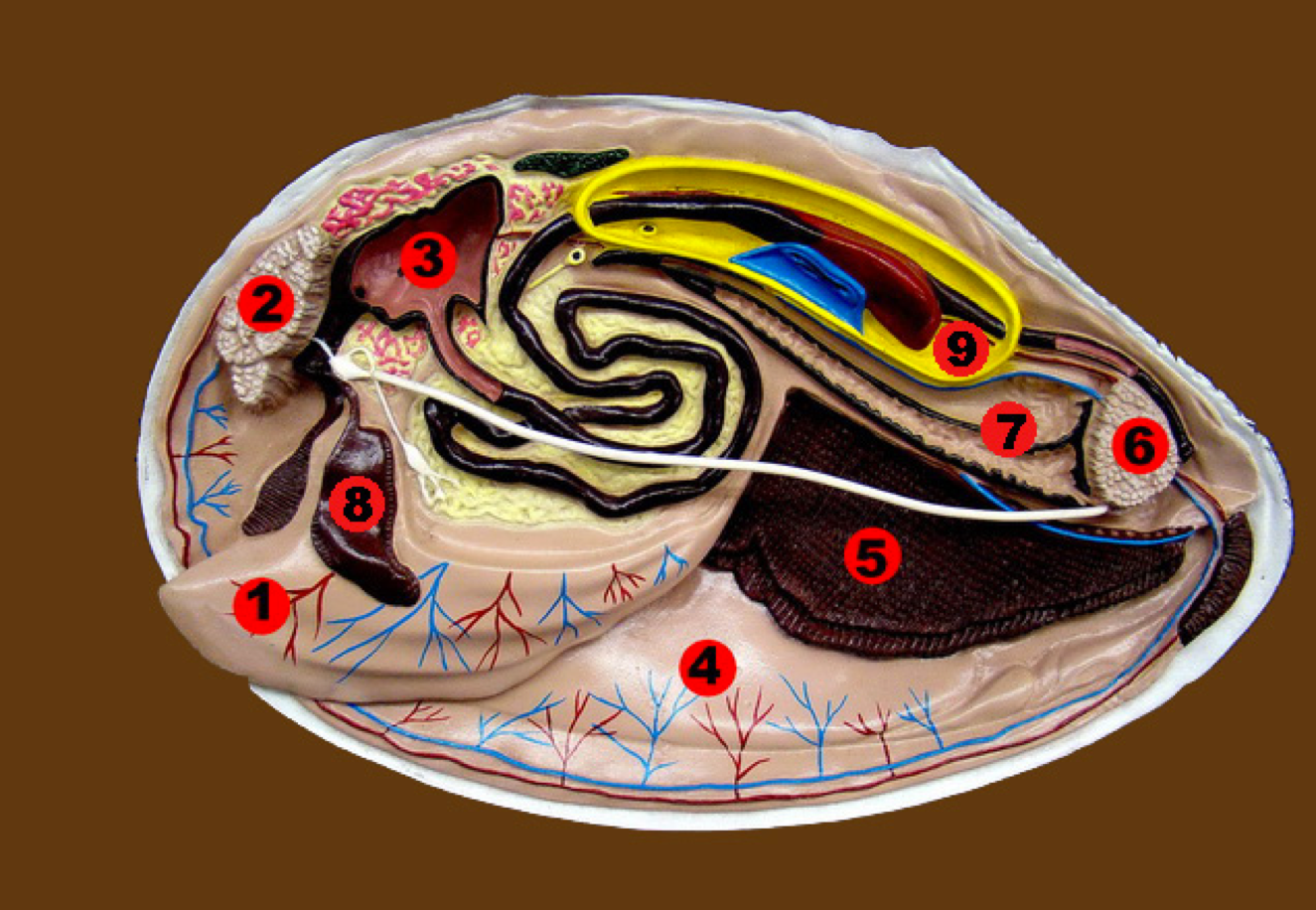
What structure is represented by the number “1” on the clam model?
foot
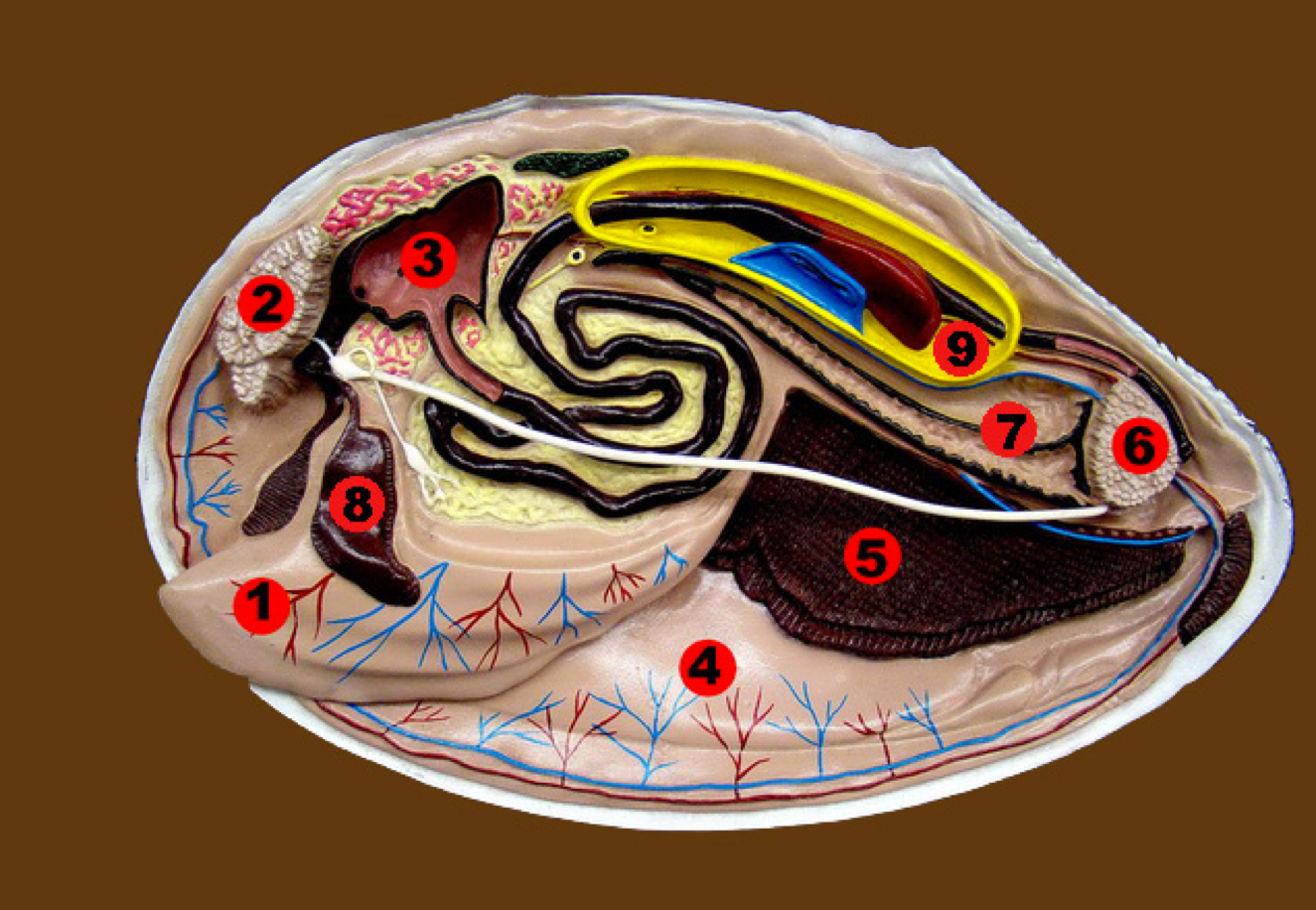
What structure is represented by the number “3” on the clam model?
stomach
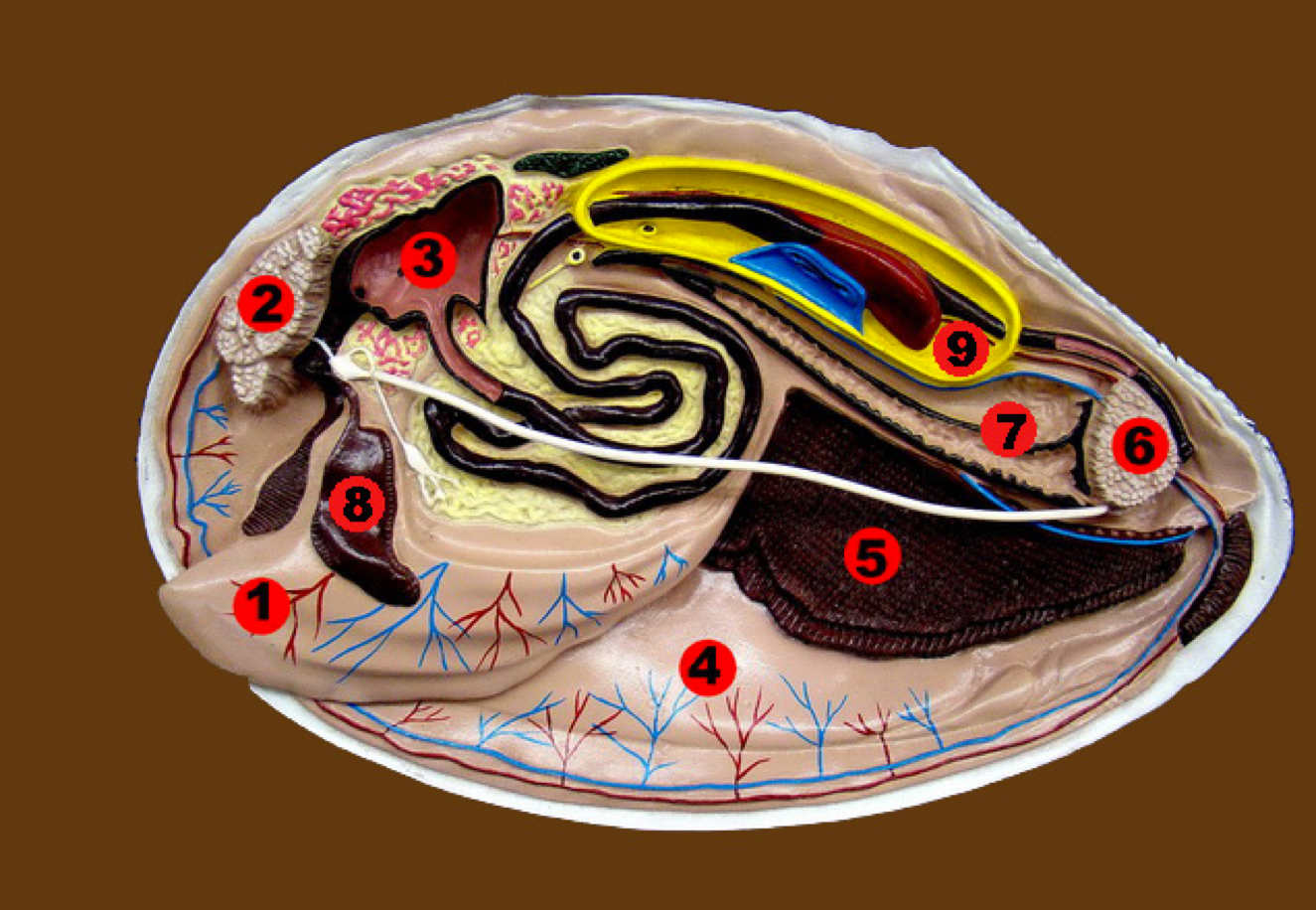
What structure is represented by the number “4” on the clam model?
mantle
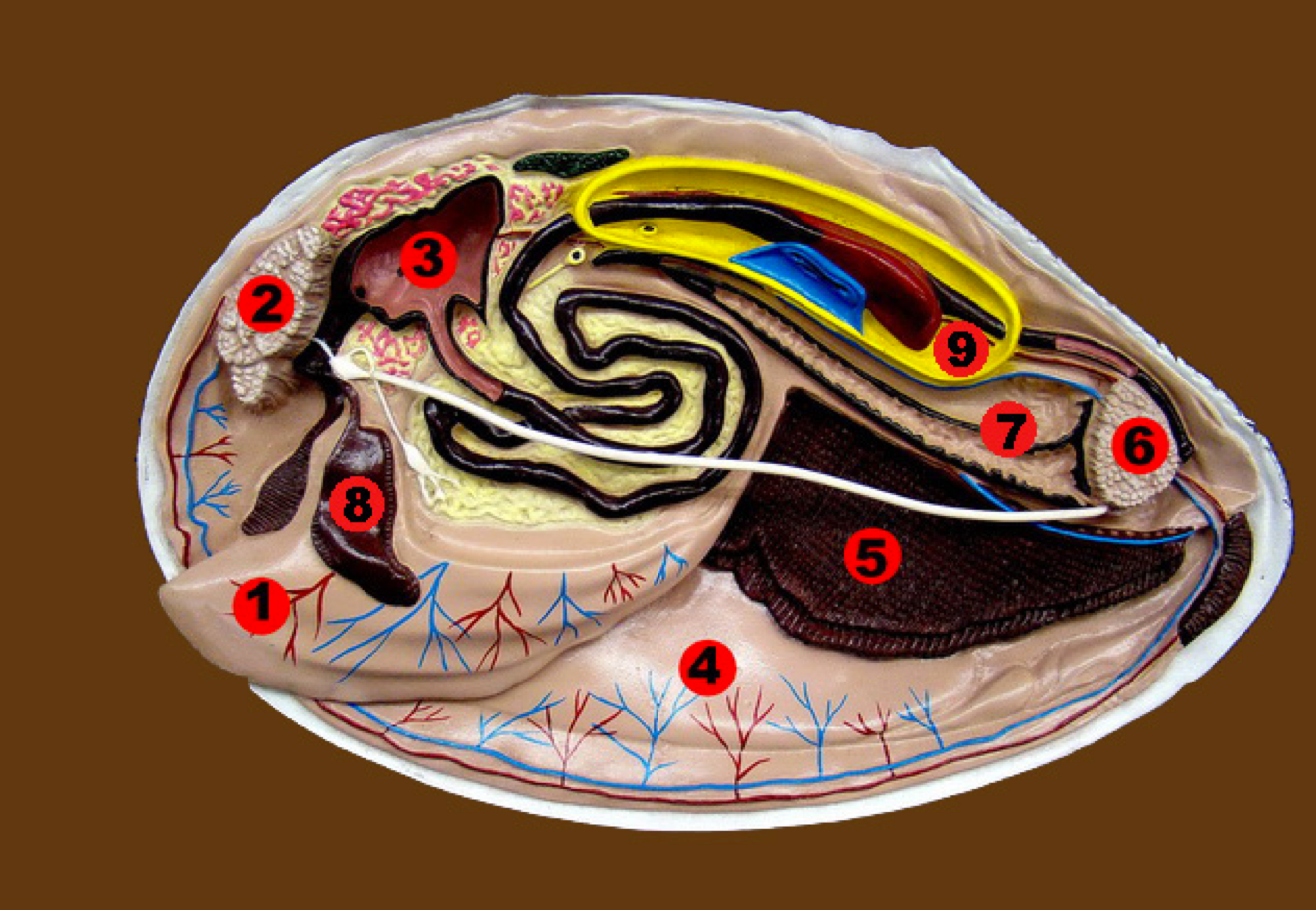
What structure is represented by the number “5” on the clam model?
gills
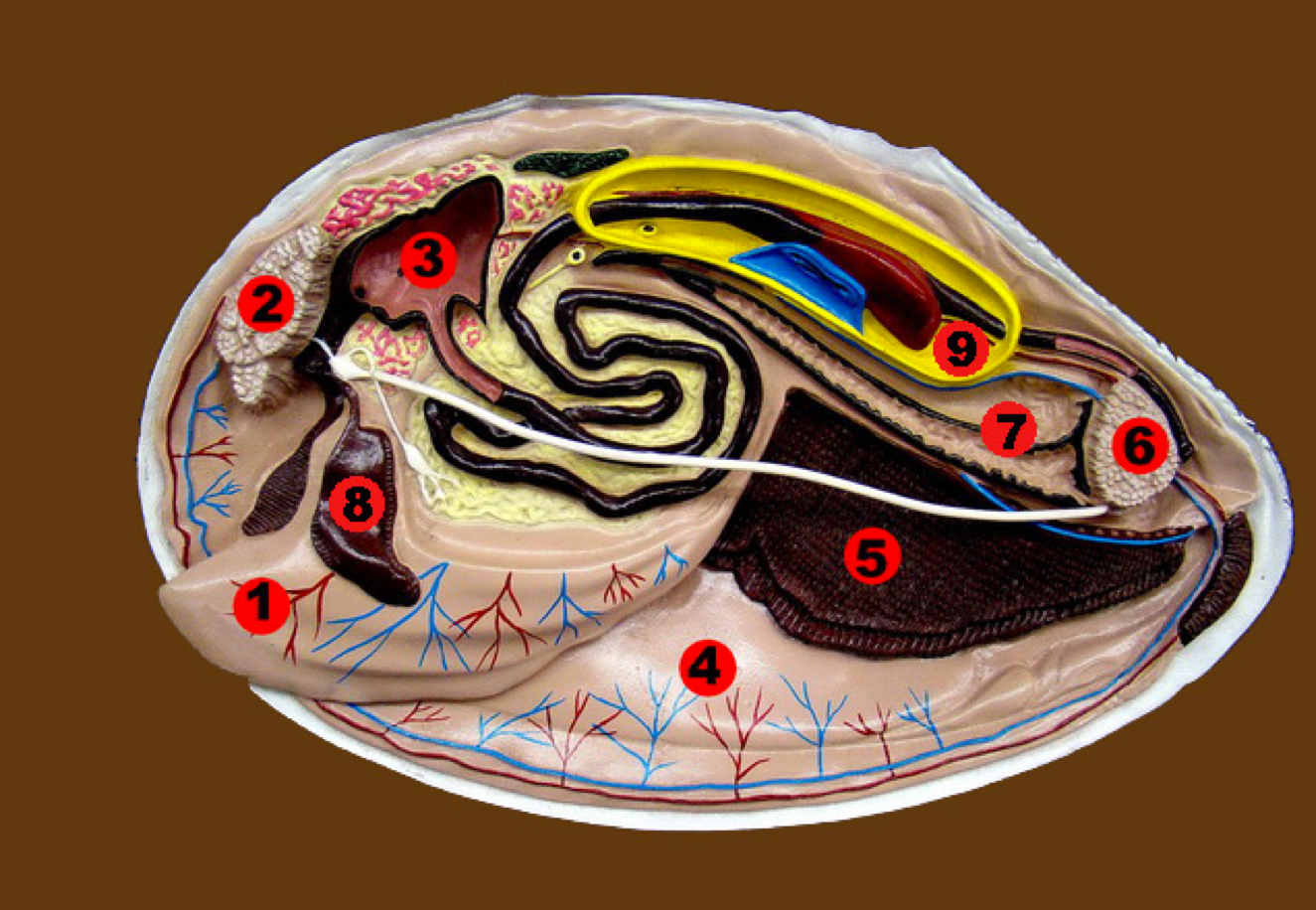
What structure is represented by the number “6” on the clam model?
posterior adductor muscle
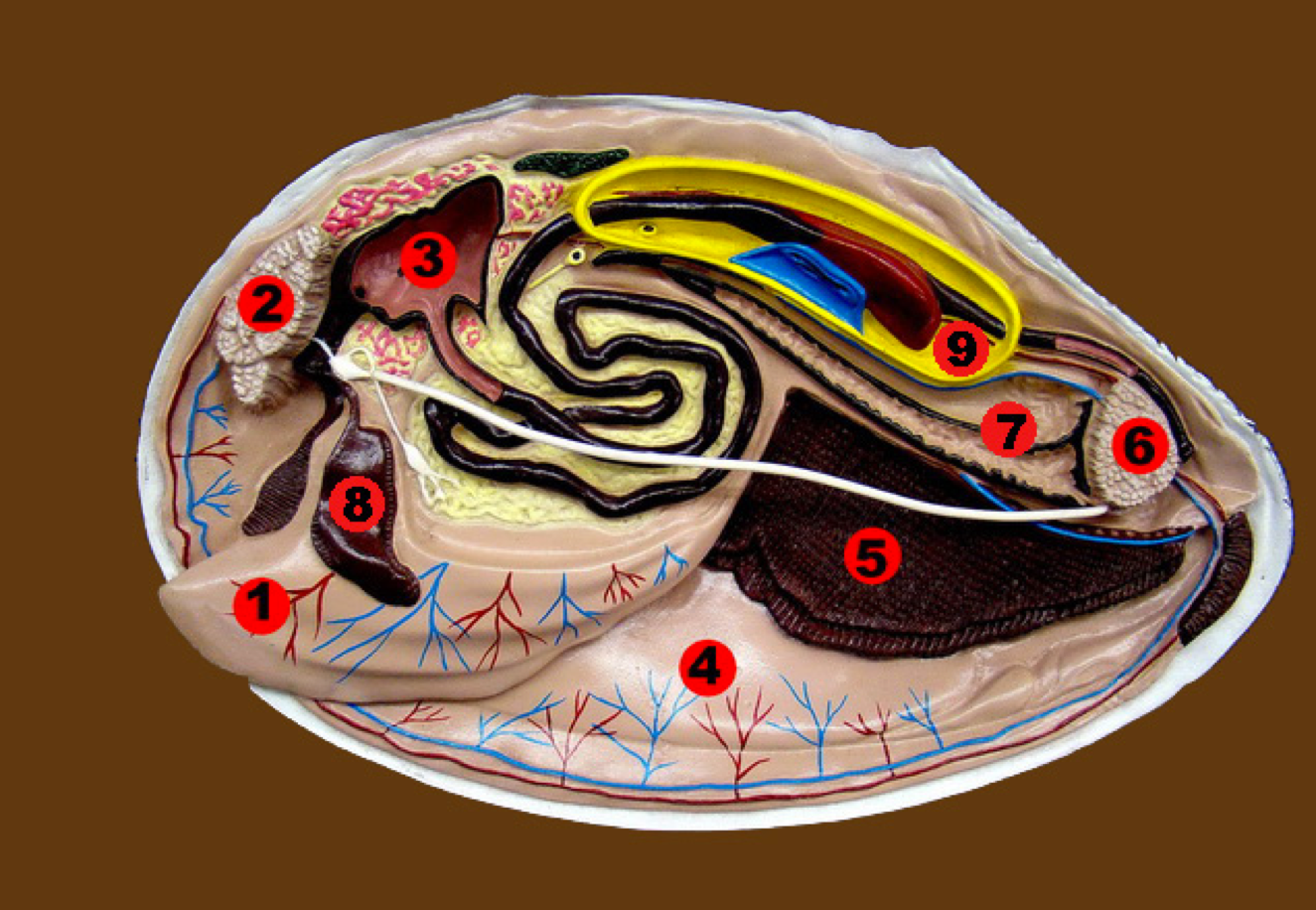
What structure is represented by the number “8” on the clam model?
labial palps
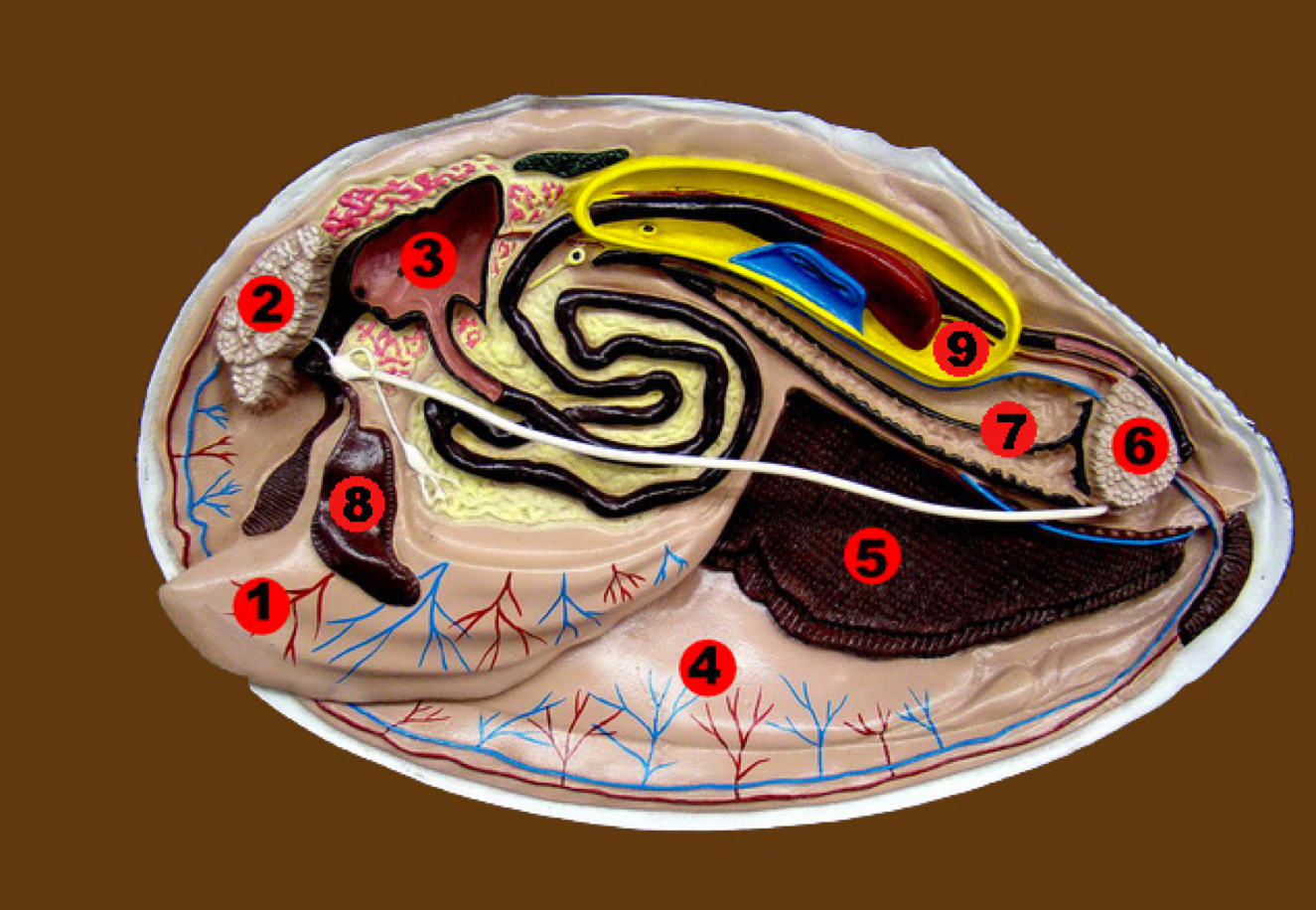
What structure is represented by the number “9” on the clam model?
heart
How do schistosomes infect humans?
A. penetration of human skin
B. ingestion of insufficiently cooked pork
C. ingestion of insufficiently cooked fish
D. ingestion of insufficiently cooked beef
A. penetration of human skin
The organ of attachment in a tapeworm is called a _____.
scolex
Tapeworms obtain nutrients by absorbing them through their body wall—they do not have digestive systems.
T. true
F. false
T. true
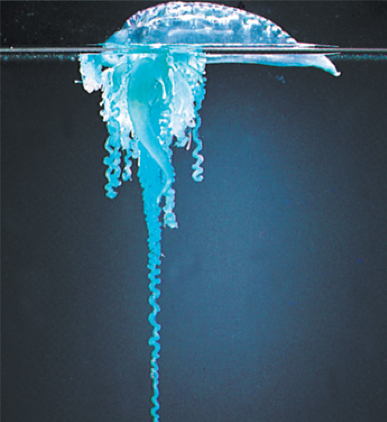
The image shows the cnidarian commonly known as portuguese man-of-war. It belongs to the class _____ in the genus physalia.
hydrozoa
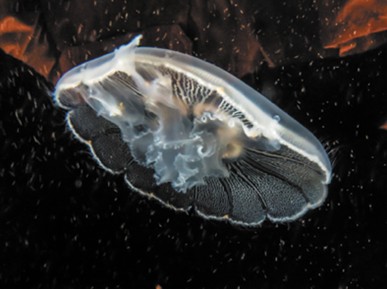
The image shows the cnidarian commonly known as moon sea jelly. It belongs to the class _____ in the genus aurelia.
scyphozoa
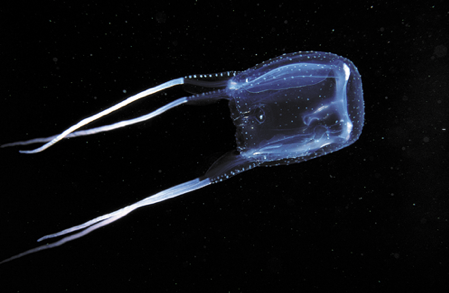
The image shows the cnidarian commonly known as box jelly. It belongs to the class _____ in the genus chironex.
cubozoa
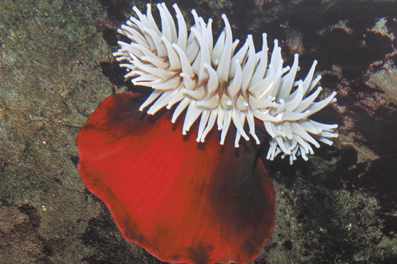
The image shows the cnidarian commonly known as sea anemone. It belongs to the class _____ in the genus metridium.
anthozoa
How do sponges avoid self-fertilization?
A. sperm are held within the body, while eggs are released into the environment
B. self-fertilization is not avoided by sponges
C. eggs and sperm are produced at different times
D. eggs are held within the body, however sperm are released into the environment
D. eggs are held within the body, however sperm are released into the environment
Match each cnidarian class with the correct representative from this lab.
1. class hydrozoa box-shaped medusae
2. class scyphozoa metridium
3. class cubozoa aurelia
4. class anthozoa obelia
1. class hydrozoa obelia
2. class scyphozoa aurelia
3. class cubozoa box-shaped medusae
4. class anthozoa metridium
The two body forms of cnidaria are the medusa and the _____.
polyp
Which is a correct statement regarding the symmetry of the adult porifera and the symmetry of the adult cnidaria?
A. both the porifera and the cnidaria are asymmetrical
B. the cnidaria are asymmetrical, while the porifera are radially symmetrical
C. the porifera are asymmetrical, while the cnidaria are radially symmetrical
D. both the porifera and the cnidaria are radially symmetrical
C. the porifera are asymmetrical, while the cnidaria are radially symmetrical
How do clams and oysters feed?
A. they are active predators
B. they scrape food off rocks
C. they are sit-and-wait predators
D. they filter food out of the water
D. they filter food out of the water
All mollusks have an open circulatory system.
T. true
F. false
F. false
What is the function of a radula?
A. feeding
B. reproduction
C. digestion
D. all of the choices are correct
A. feeding
Clams open their shells using abductor muscles.
T. true
F. false
F. false
Which of the following belongs to the subgroup trematoda?
A. opisthosomas
B. taenia
C. fasciola
D. tubellaria
C. fasciola
On your laboratory test, you are presented with a mollusc that has a closed circulatory system. You know immediately that it must belong to the class _____.
A. gastropoda
B. bivalvia
C. solenogastres
D. cephalopoda
D. cephalopoda
Humans can avoid many types of parasitic infections by sufficiently cooking their food.
T. true
F. false
T. true
Which are cnidarian body layers? Check all that apply.
A. mesoglea
B. mesohyl
C. ectoderm
D. endoderm (gastroderm)
A. mesoglea
C. ectoderm
D. endoderm (gastroderm)
Sponge digestion occurs intracellularly.
T. true
F. false
T. true
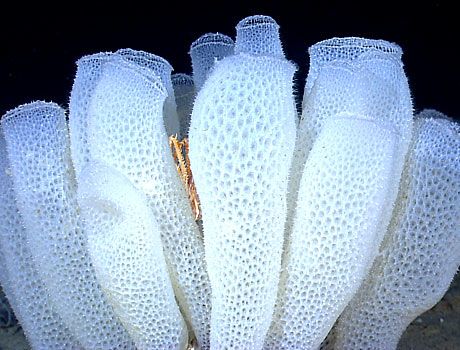
The sponges above are commonly known as venus flower basket. They belong to the class hexactinellida and genus _____.
euplectella
Which are modes of asexual reproduction in sponges?
A. parthenogenesis
B. binary fission
C. budding
D. germination
C. budding
Is often called planaria, a common freshwater turbellaria.
A. fluke
B. fasciola
C. flat worm
D. dugesia
D. dugesia
Where can nematodes be found? Check all that apply.
A. in host environments
B. in aquatic environments
C. in terrestrial environments
A. in host environments
B. in aquatic environments
C. in terrestrial environments
Which nematode causes the disease trichinosis?
A. trichinella
B. turbatrix
C. rhabditus
D. ascaris
A. trichinella
The phylum nematode also called roundworms, contain what type of body cavity?
A. psedocoelom
B. coelom
C. acoelomate
D. coelomate
A. psedocoelom
Nematode that can infect intestinal tract of humans and other vertebrates.
A. turbatrix
B. trichinella
C. rhabditus
D. ascaris
D. ascaris
Which features do nematodes have that make them more advanced than flatworms? Check all that apply.
A. capacity to make thousands of eggs
B. bilateral symmetry
C. some species are free-living
D. fluid-filled space between body wall and gut
E. complete digestive tract
D. fluid-filled space between body wall and gut
E. complete digestive tract
Your instructor has assigned an unknown animal to your lab group for you to identify. The only information you are given is it is either a member of the phylum mollusca or the phylum annelida, it is discussed in this lab, and the animal you are observing is an adult. As your group observes the animal, you note the following: tentacles, a prostomium, a peristomium, a closed circulatory system, and parapodia. What is the identity of this creature?
A. hirudu
B. nautilus
C. chiton
D. nereis
D. nereis
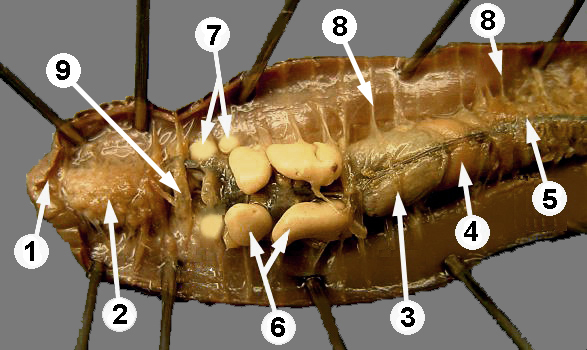
What structure is represented by the number "1" on the dissected earthworm?
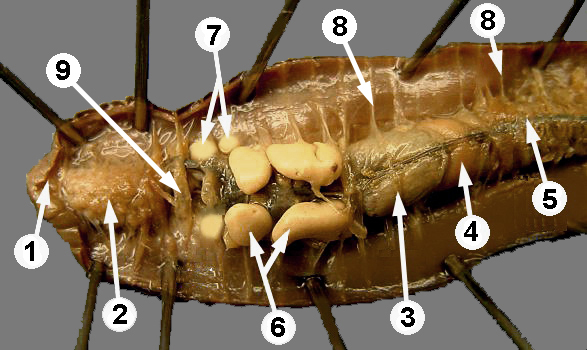
What structure is represented by the number "2" on the dissected earthworm?
pharynx
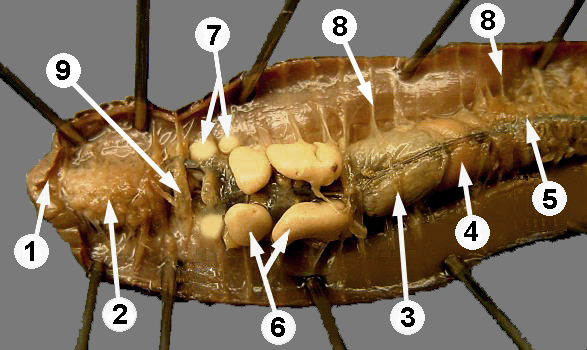
What structure is represented by the number "3" on the dissected earthworm?
crop

What structure is represented by the number "4" on the dissected earthworm?
gizzard
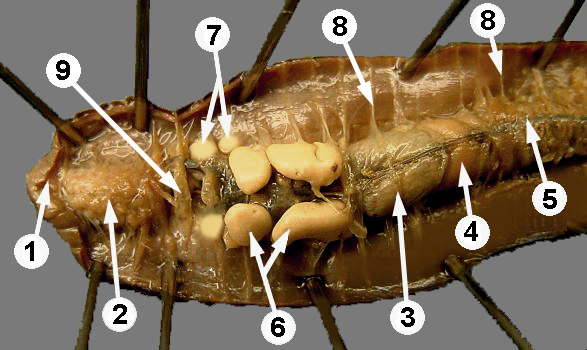
What structure is represented by the number "5" on the dissected earthworm?
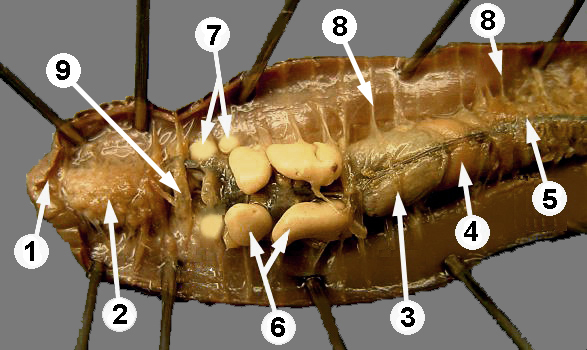
What structure is represented by the number "6" on the dissected earthworm?
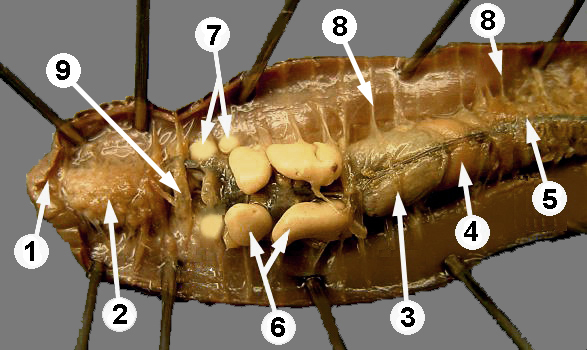
What structure is represented by the number "7" on the dissected earthworm?
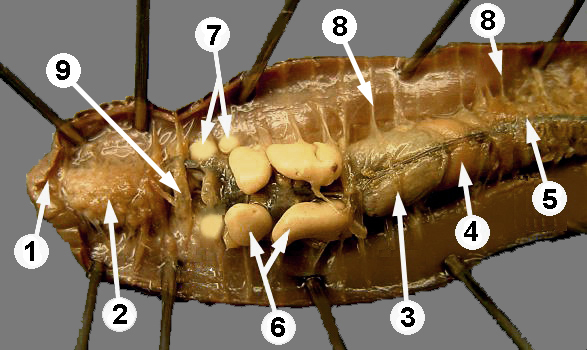
What structure is represented by the number "8" on the dissected earthworm?
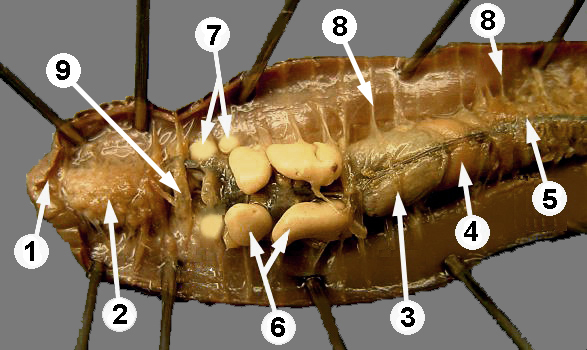
What structure is represented by the number "9" on the dissected earthworm?
aortic arches
Spiders are classified as insects.
T. true
F. false
F. false
What has contributed to the enormous abundance of arthropods? Check all that apply.
A. external skeleton
B. closed circulatory system
C. pseudocoel
D. jointed legs
A. external skeleton
D. jointed legs
Which feature is characteristic only of crustaceans?
A. endoskeleton
B. exoskeleton
C. jointed legs
D. two pairs of antennae
D. two pairs of antennae
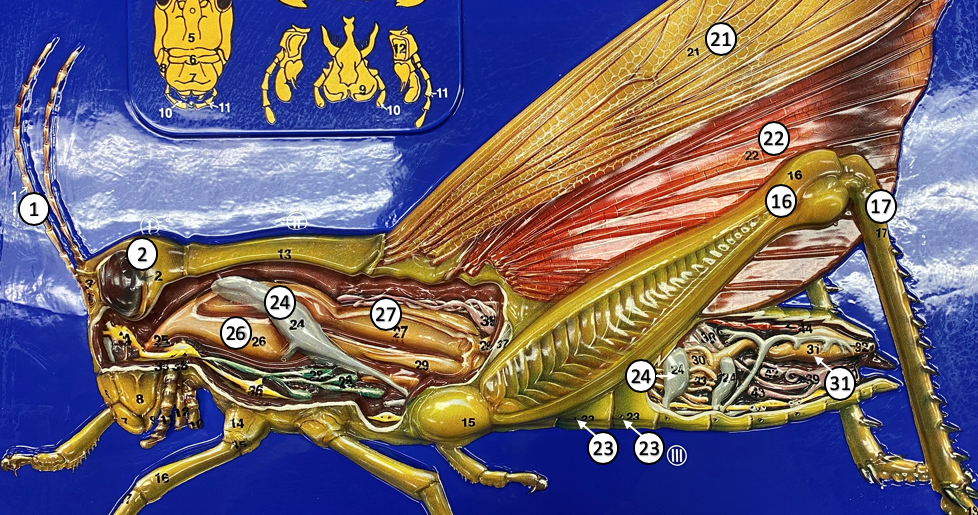
What structure is represented by the number "16" on the grasshopper model?
femur
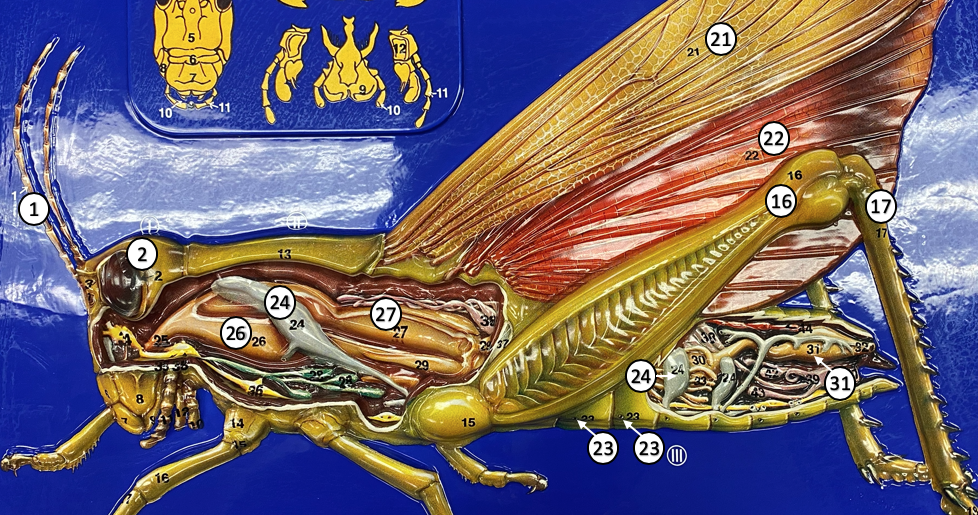
What structure is represented by the number "17" on the grasshopper model?
tibia
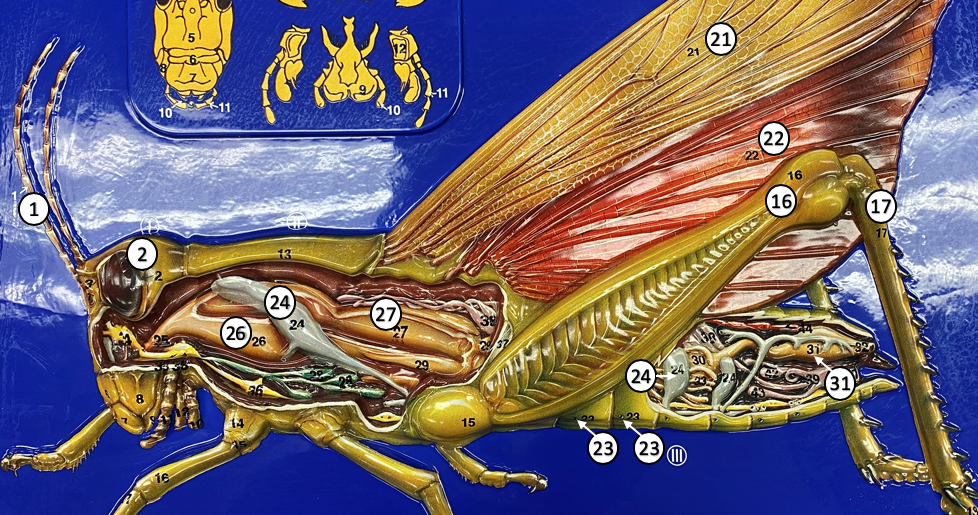
What structure is represented by the number "21" on the grasshopper model?
forewing
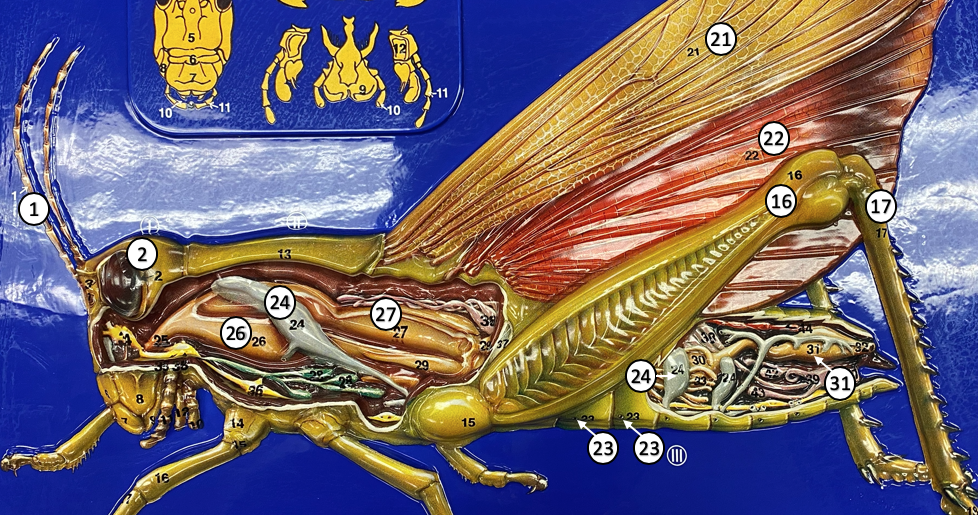
What structure is represented by the number "26" on the grasshopper model?
crop
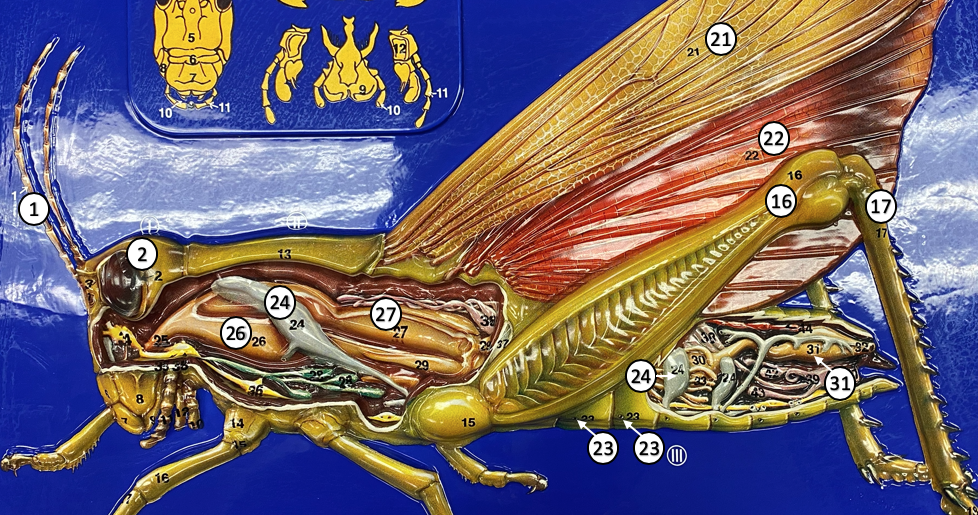
What structure is represented by the number "27" on the grasshopper model?
gizzard
Millipedes have two legs per segment, while centipedes have four legs per segment.
T. true
F. false
F. false
What are the major factors that have contributed to the success of insects? Check all that apply.
A. highly specialized mouthparts
B. ability to fly
C. efficient conduction of air throughout the body
D. possession of eight legs
A. highly specialized mouthparts
B. ability to fly
C. efficient conduction of air throughout the body
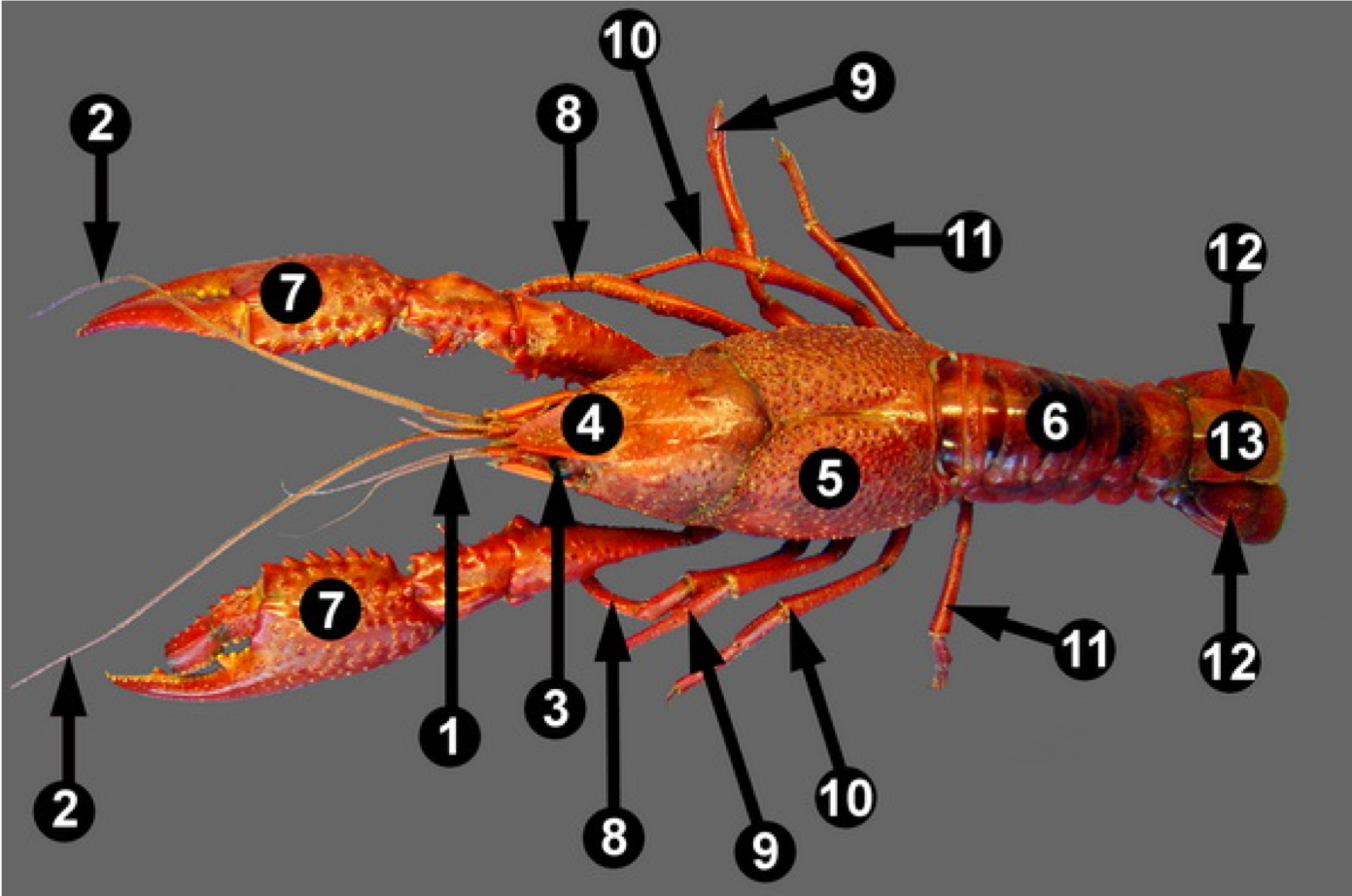
What structure is represented by the number "1" on the crayfish?
antennules
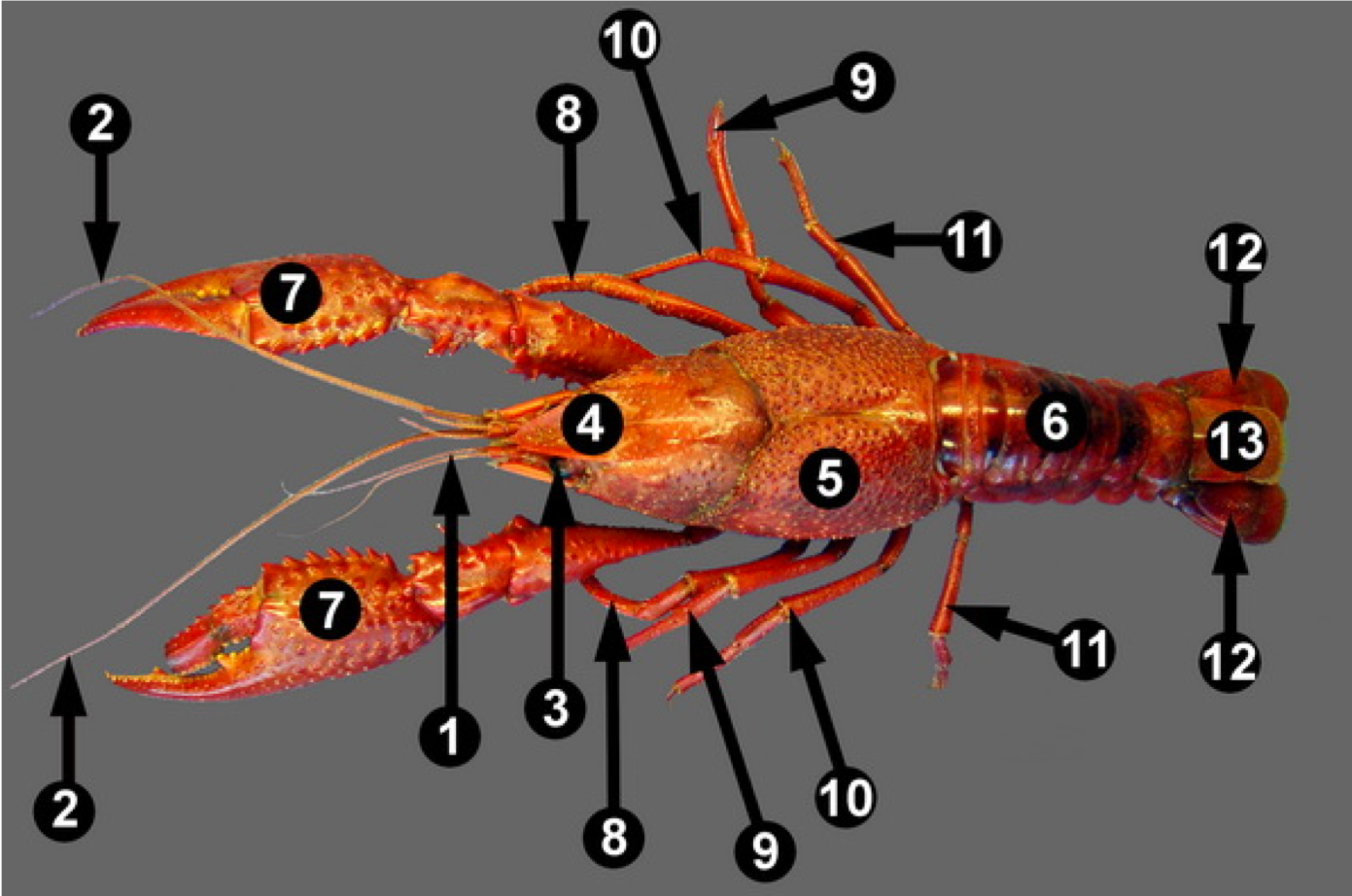
What structure is represented by the number "2" on the crayfish?
antennae
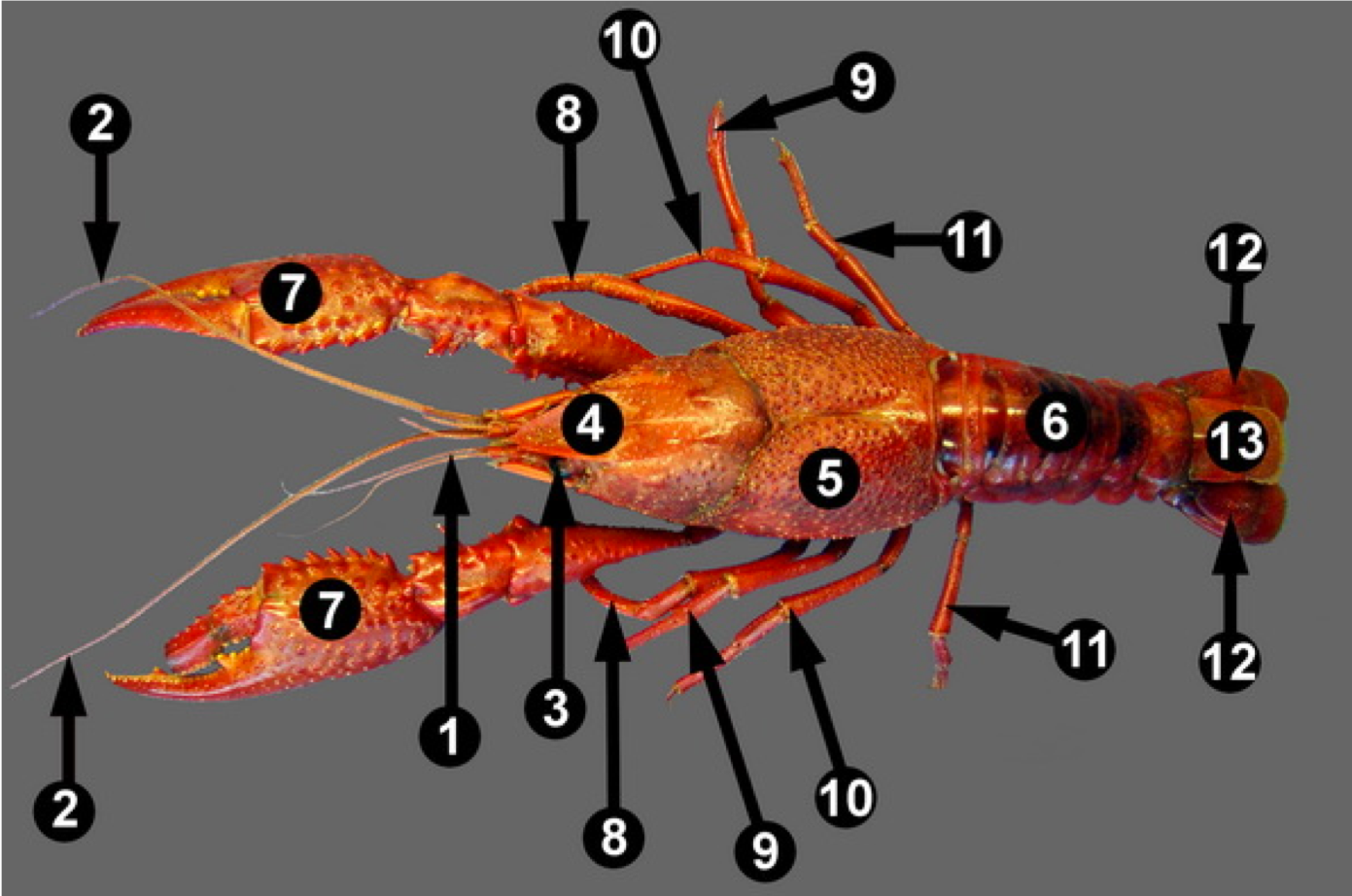
What structure is represented by the number "3" on the crayfish?
compound eye
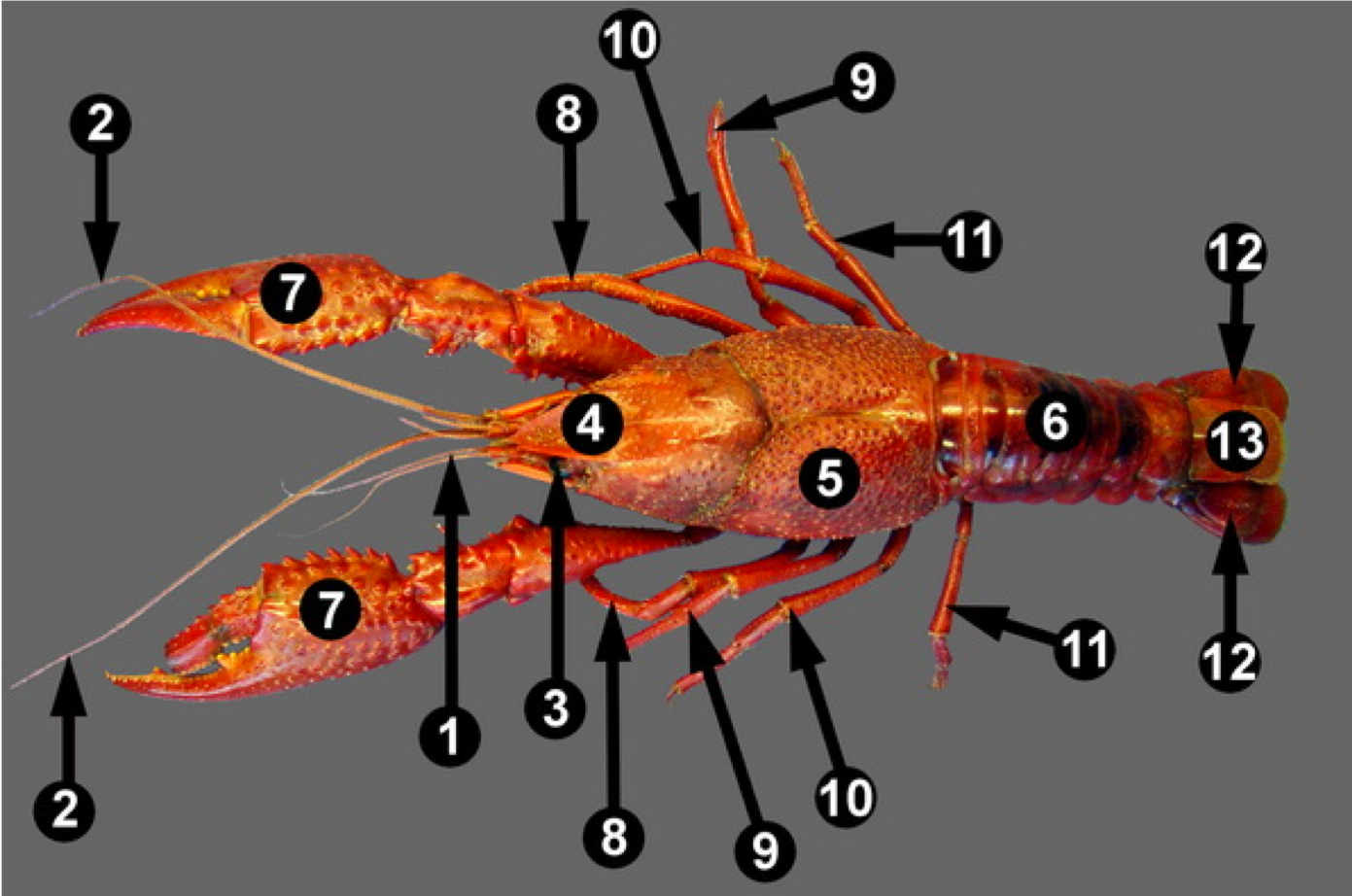
What structure is represented by the number "4" on the crayfish?
rostrum
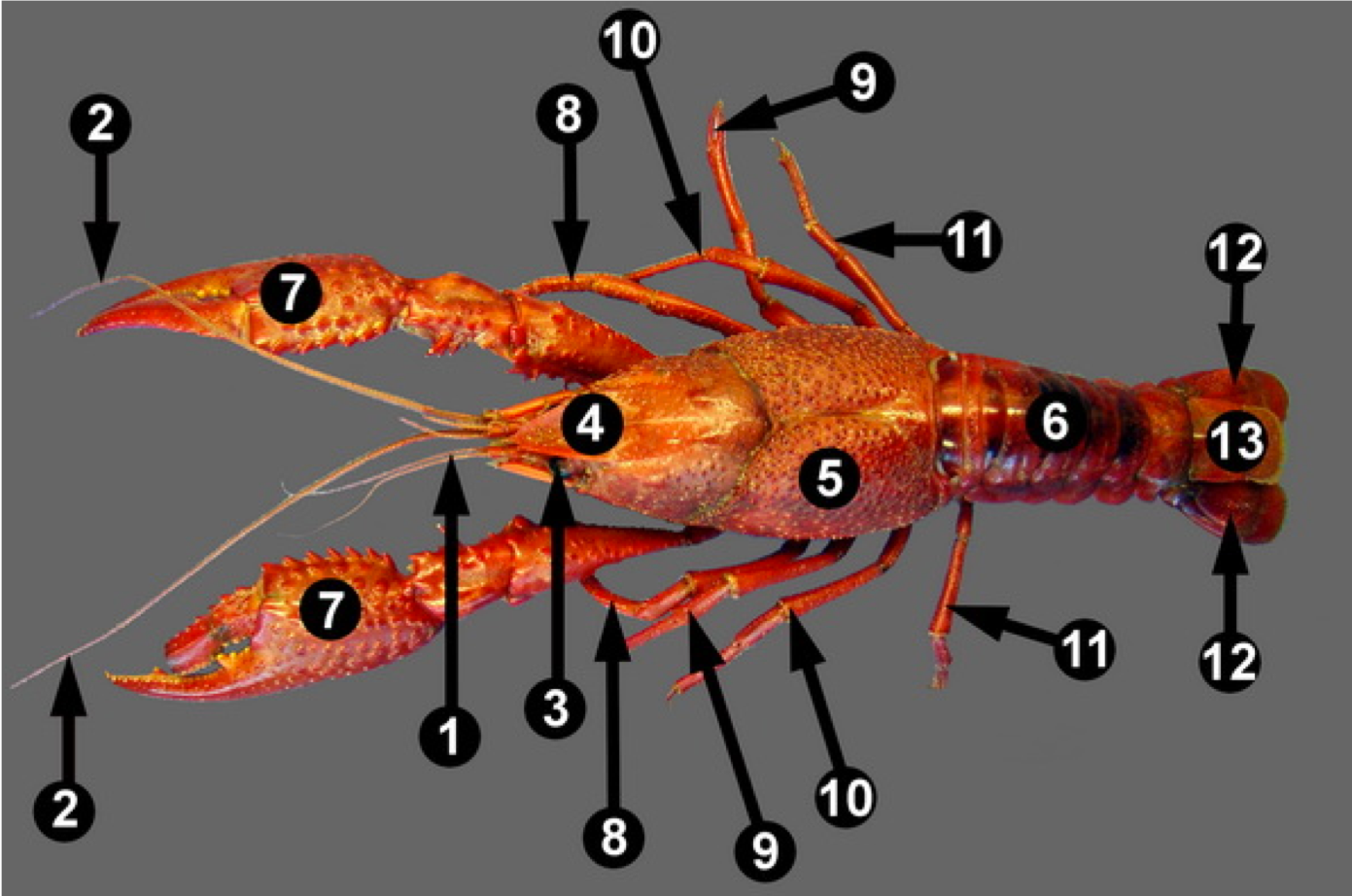
What structure is represented by the number "5" on the crayfish?
carapace
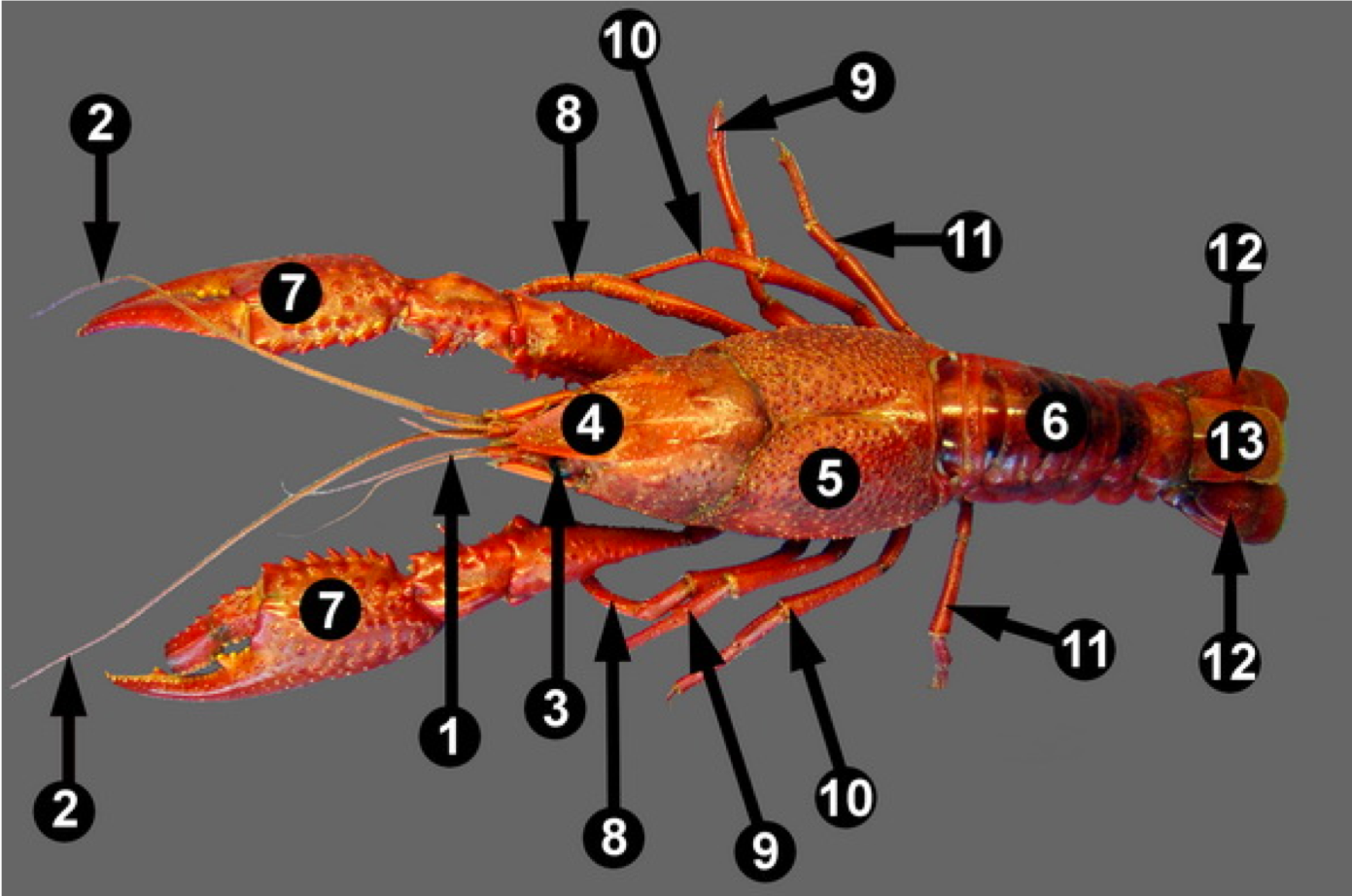
What structure is represented by the number "6" on the crayfish?
abdomen
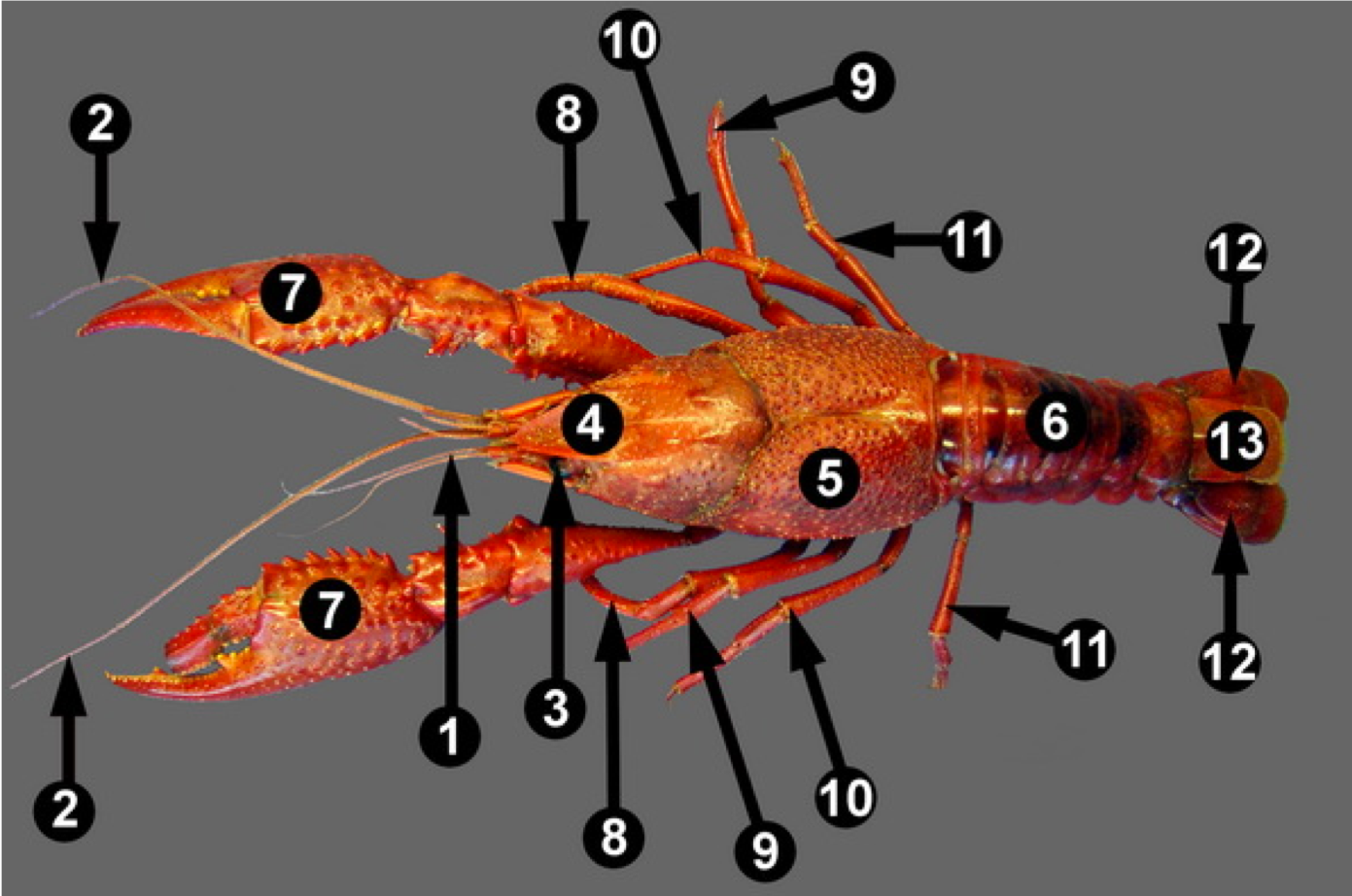
What structure is represented by the number "7" on the crayfish?
cheliped
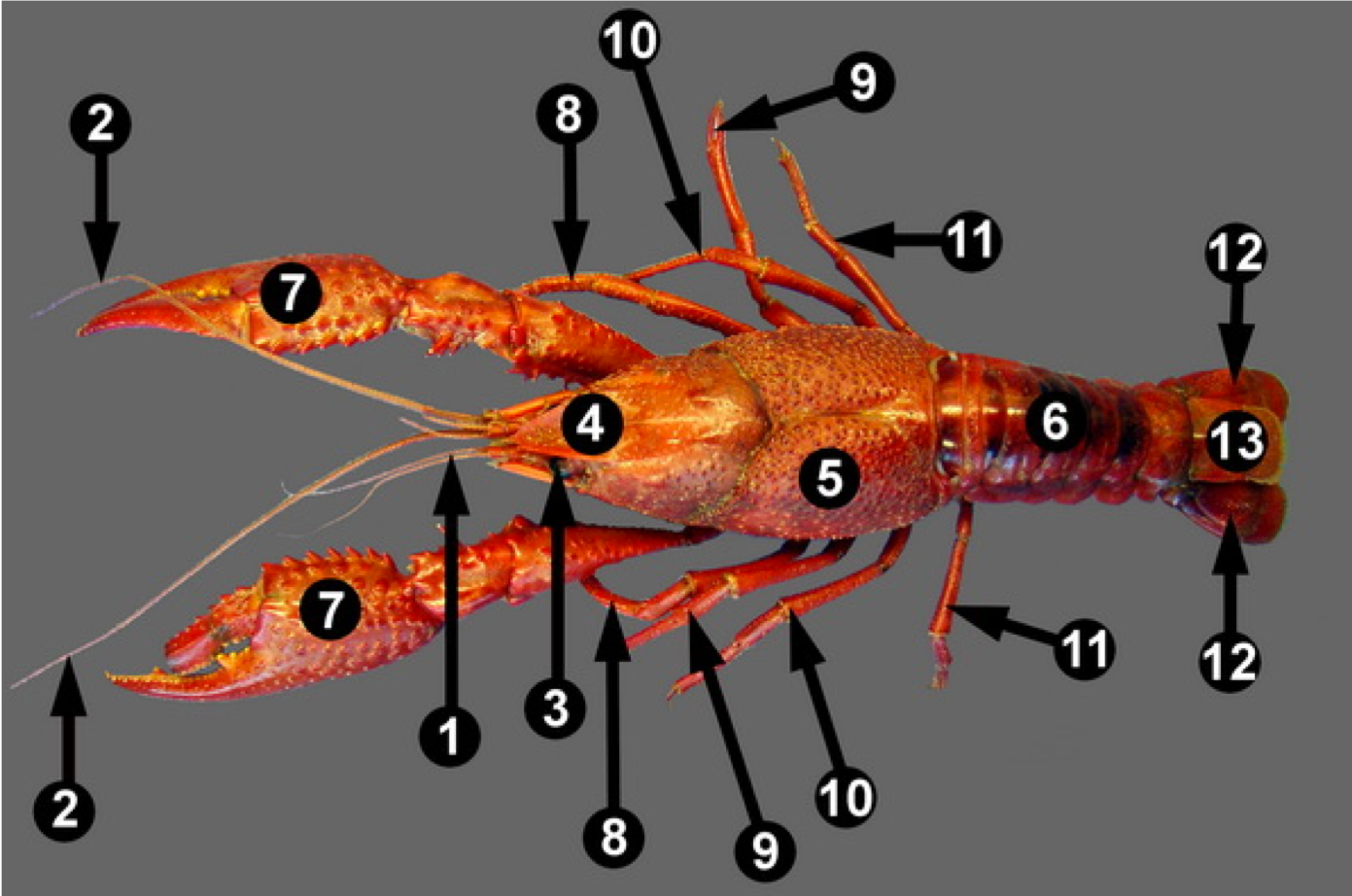
What structures are represented by the numbers "8" through “11” on the crayfish?
walking legs
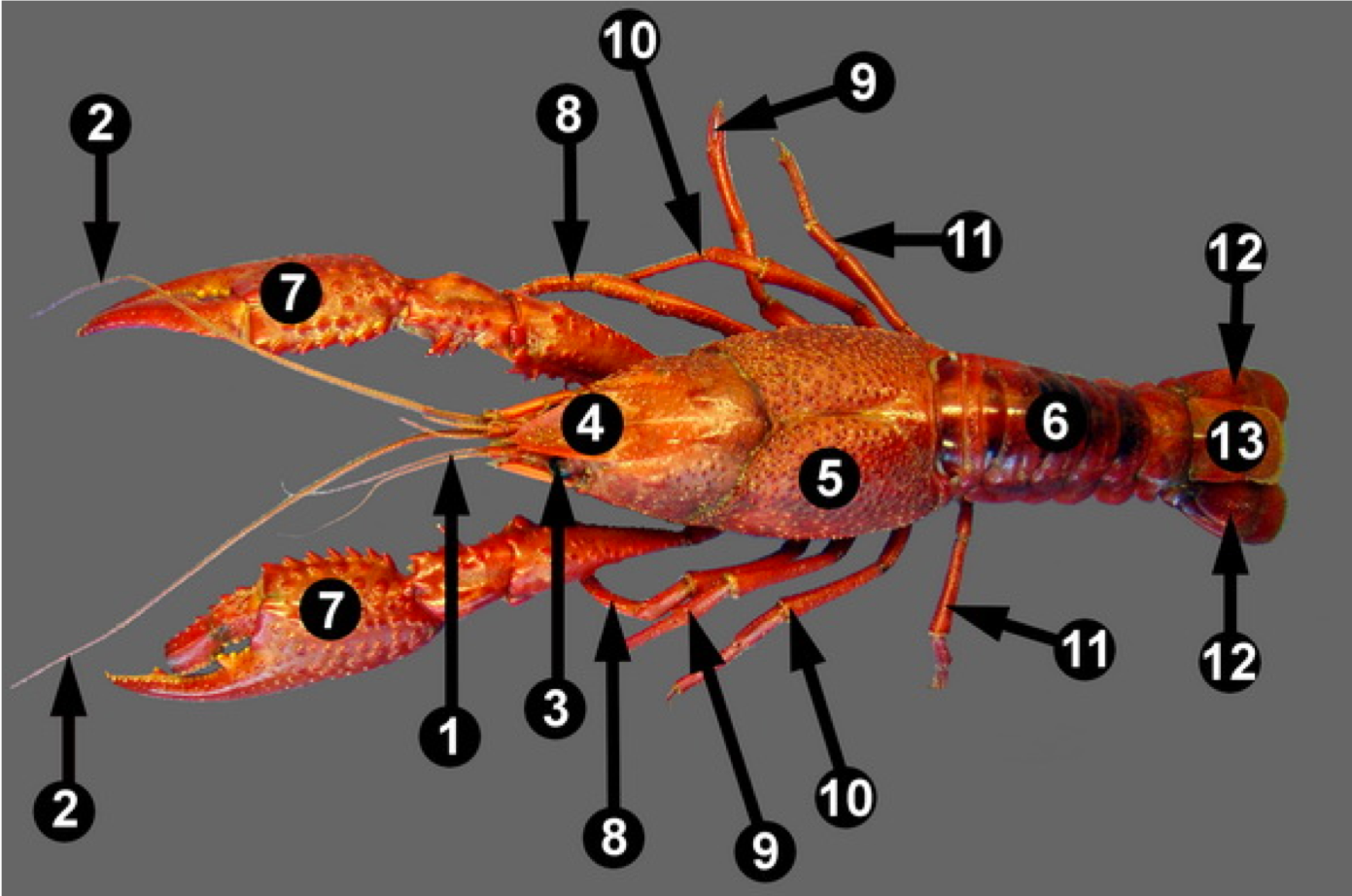
What structure is represented by the number "12" on the crayfish?
uropods
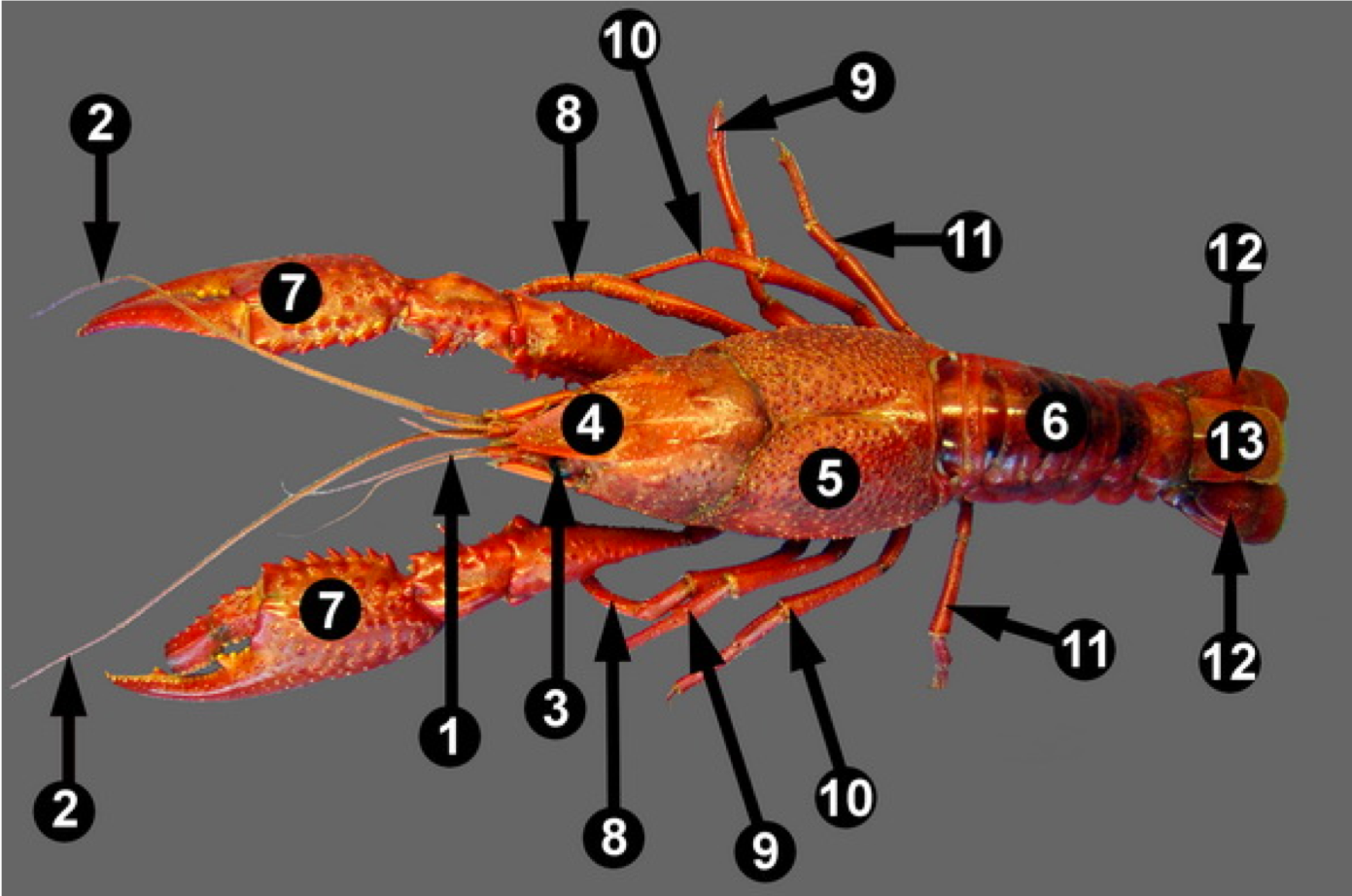
What structure is represented by the number "13" on the crayfish?
telson
What is the function of the telson?
A. it is used to turn the horseshoe crab over if it is stranded on its back
B. it is used in prey capture
C. it is used for reproduction
D. it is a poisonous stinger
A. it is used to turn the horseshoe crab over if it is stranded on its back
To which body segment are spider legs attached?
A. abdomen
B. thorax
C. head
D. cephalothorax
D. cephalothorax
Internal anatomy of an earthworm is used for suction and ingestion of food.
A. gizzard
B. esophagus
C. pharynx
D. typhlosole
C. pharynx
On your laboratory test, you are presented with an annelid that has no setae. You know immediately that it must belong to the class _____.
A. oligochaeta
B. polychaeta
C. hirudinea
C. hirudinea
The circulatory system of arthropods shares more features and is more similar to that of molluscs than it is to the circulatory system of annelids.
T. true
F. false
T. true